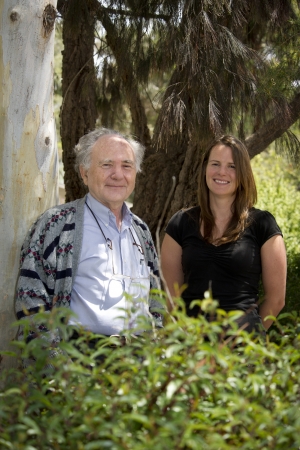Males up to their old tricks
Research news
Deakin University biologists have found that males with the best visual trickery techniques are more successful at mating, for great bowerbirds that is.
Researchers within Deakin’s Centre for Integrative Ecology Professor John Endler and Dr Laura Kelley, with significant support from James Cook University, have been studying the male great bowerbird’s use of visual illusions in constructing bowers. They have found that the quality of the visual illusion created within the bower promotes mating success. The results of their research are published in the latest issue of Science.
“Last year we revealed that male great bowerbirds use an optical illusion known as forced perspective to construct their bowers. The scene created only works from the female’s viewing angle and could trick the female by altering her perception of the male’s display. We have now found that the quality of the illusion ultimately predicts mating success,” Professor Endler said.
The great bowerbird (Ptilonorhynchus nuchalis) is found in northern parts of Australia and, as with all bowerbirds, is well-known for the large and elaborately decorated bowers the males construct to attract females.
The bird’s bower consists of a 60 centimetre long tunnel-like avenue made of sticks that leads to a court area decorated with stones, shells and bones. As part of the mating ritual, the female stands in the avenue to watch the male put on a show in the court; he flashes his purple crest and waves coloured objects to entice the female to mate.
“The forced perspective within the bower is generated by a gradient of court object sizes where smaller objects are placed closer to where the female is watching within the avenue and larger objects are further away, all within her field of view. This gives the illusion that the court is smaller than it is and anything displayed within the court is larger than it really is,” Professor Endler explained.
“We know that this doesn’t happen by chance. When we improved or reversed the size order of the objects in the courts, the males put them back within three days. Bower geometry is obviously very important to them.”
The latest findings show that the males that produce the best perspective gradients are more successful at gaining mates.
“We found that there is a lot of variation in how well the males can construct the ideal gradient,” Dr Kelley said.
“The best quality bowers had a steeper gradient where the size of the objects increased more rapidly with distance and had a more regular, smoother pattern. The best predictor of mating success though is when we consider how the gradient looks from the female’s point of view: males that construct courts that look evenly patterned to the female within the bower attract the most mates.
“Forced perspective may affect how the female perceives the male’s display in a number of ways. The regular pattern of the court may make the male’s crest and coloured objects more conspicuous, or the perspective and other illusion effects may make them appear larger. Further illusions may also be produced when the male waves his display objects. This is a clever act of deception by the male bowerbird.”
The researchers are now analysing video footage of the males building their bowers to determine how they construct the gradients.
“We want to figure out exactly what males do after we have reversed or removed the gradients,” Professor Endler said.
“There could be a number of ways they are constructing the gradients. Do they have a direct sense of perspective and put the objects back in the right order straight away; do they put them back at random and go inside the avenue and look and move objects by trial and error; or is there a simple rule of thumb in placing small things closer, big things further out and everything else in between?”
Watch Professor Endler, Dr Kelly - and the Great Bowerbird - on Youtube
Share this story
 "The forced perspective within the bower is generated by a gradient of court object sizes where smaller objects are placed closer to where the female is watching within the avenue and larger objects are further away, all within her field of view. This gives the illusion that the court is smaller than it is and anything displayed within the court is larger than it really is," says Professor John Endler.
"The forced perspective within the bower is generated by a gradient of court object sizes where smaller objects are placed closer to where the female is watching within the avenue and larger objects are further away, all within her field of view. This gives the illusion that the court is smaller than it is and anything displayed within the court is larger than it really is," says Professor John Endler.
